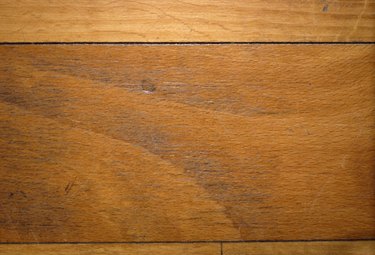Things You'll Need
Safety glasses
Ear protection
Chalk line
Circular saw
Sander
Scraper
Shims
Hammer
Nails
OSB or plywood
Edger and abrasives

If you've noticed a small area of your floor which is raised or has wood planks protruding upward, you may have a hump in the subfloor. Whether you're planning to replace an existing floor or not, a hump in a subfloor requires removing the problem before it worsens. A hump in a subfloor occurs for different reasons. For instance, the builder may not have properly installed the subfloors Regardless of the reason, you have to repair the subfloor to preserve your existing floor or make sure that your newly installed floor doesn't sustain future damage.
Measure the floor
Step 1
Measure the height difference between the hump and rest of the floor. Use a straightedge to measure the hump and other high and low points of the entire area. You may notice a difference of approximately 3 inches.
Video of the Day
Step 2
Remove the existing flooring. To remove the existing floor, use a circular saw. Cut only the area where the hump is – not the entire floor.
Step 3
Inspect the subfloor to see if there's any damage or a way to remove the hump without further cutting.
Removing a Hump with Sleeper System
Step 1
Eliminate the sleeper system. A sleeper system, located underneath the subfloor, is an area between the subfloor and floor. It can be as high as 1/2 inch high.
Step 2
Clean the area. Remove any debris, nails and sleepers from the area.
Step 3
Place shims on the subfloor. Nail the shims every 12-14 inches down the exposed floor. Stack them on top of one another to achieve the desired height, leaving at least 1/2 inch for the top of the subfloor.
Step 4
Place the plywood over the shims. Use a chalk line to check the evenness of the new floor.Then nail the plywood onto the floor.
Step 5
Use an edger. To smooth out the plywood with the existing subfloor, run the edger over the areas.
Step 6
Affix new floor over subfloor.
Removing a Hump with a Joist Problem
Step 1
Cut the subfloor. Use a circular saw to remove the subfloor to expose the high joist.
Step 2
Look at the joist. The joist underneath the hump may appear thicker than the joist on either side of it because of moisture.
Step 3
Shave down the higher joist. You want the joist at the same height as the other ones.
Step 4
Install the subfloor. Place the plywood over the joists and nail it down.
Step 5
Mount the new floor over the subfloor.
Tip
Besides moisture, improper installation can cause one joist to be higher than the others. A contractor may attempt to even out the floor by placing a new, higher joist next to existing ones.
Warning
Always use safety glasses and ear protection when using machinery such as a circular saw to eliminate possibilities of injury or hearing damage.
Video of the Day